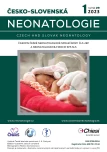-
Medical journals
- Career
Perinatal strokes
Authors: K. Maťašová 1; Z. Trabalková 2
Authors‘ workplace: Neonatologická klinika, Jesseniova lekárska fakulta UK a Univerzitná nemocnica, Martin 1; Rádiologická klinika, Jesseniova lekárska fakulta UK a Univerzitná nemocnica, Martin 2
Published in: Čes-slov Neonat 2023; 29 (1): 24-33.
Category: Reviews
Overview
Perinatal strokes represent a group of cerebrovascular diseases, that cause a focal injury in developing brain. They occur between 20th gestational week and 28th postnatal day. Clinical manifestation is either acute, typically by seizures within the first postnatal days, or they present later, during the first year of life by impaired psychomotor development and hemiparetic cerebral palsy. The brain injury results from the interruption of the blood flow in the arterial or venous part of cerebral circulation leading to focal ischemia and / or haemorrhage. Although the incidence is relatively high, the causative mechanisms are not completely understood. In the diagnosis it is necessary to think about strokes and indicate imaging examination early. Early treatment can minimise consequences of perinatal stroke. Along with neuroprotection, endovascular treatment should be considered in the patient management. A child with perinatal stroke requires a long-term follow up and intensive rehabilitation. Beside motor impairment, epilepsy and cognitive disorders are common complications.
Keywords:
stroke – newborn – thrombosis – seizures – ischemia
Sources
1. Bernson-Leung ME, Boyd TK, Meserve EE, et al. Placental pathology in neonatal stroke: a retrospective case-control study. J Pediatr 2018; 195 : 39–47. doi: 10.1016/j.jpeds.2017.11.061
2. Campi F, Longo D, Bersani I, et al. Neonatal cerebral venous thrombosis following maternal SARS-CoV-2 infection in pregnancy. Neonatology 2022; 119 : 268–272. doi: 10.1159/000520537.
3. Curtis C, Mineyko A, Massicotte P, et al. Thrombophilia risk is not increased in children after perinatal stroke. Blood 2017; 129 : 2793–2800. doi: 10.1182/blood-2017-06-789404.
4. Dunbar M, Kirton A. Perinatal stroke: mechanisms, management, and outcomes of early cerebrovascular brain injury. Lancet Child Adolesc Health 2018; 2 : 666–676. doi: 10.1016/S2352 - 4642(18)30173-1.
5. Dunbar M, Mineyko A, Hill M, et al. Population based birth prevalence of disease-specific perinatal stroke. Pediatrics 2020; 146: e2020013201. doi: 10.1542/peds.2020-013201.
6. Elgendy MM, Puthuraya S, LoPiccolo C, et al. Neonatal stroke: Clinical characteristics and neurodevelopmental outcomes. Pediatr Neonatol 2022; 63 : 41–47. doi: 10.1016/j.pedneo. 2021.06.017.
7. Ferriero DM, Fullerton HJ, Bernard TJ, et al. American Heart Association Stroke Council and Council on Cardiovascular and Stroke Nursing. Management of stroke in neonates and children: a scientific statement from the American Heart Association/ American Stroke Association. Stroke 2019; 50: e51–e96. doi: 10.1161/STR.0000000000000183.
8. Fluss J, Dinomais M, Chabrier S. Perinatal stroke syndromes: similarities and diversities in aetiology, outcome and management. European Journal of Paediatric Neurology 2019; 23, 368–383. ff10.1016/j.ejpn.2019.02.013ff. ffhal-02535039
9. Goldman-Yassen AE, Dehkharghani S. Neuroimaging in perinatal stroke and cerebrovascular disease. In: Dehkharghani S. editor. Stroke [Internet]. Brisbane (AU): Exon Publications; 2021: chapter 1. Dostupné na: https://www.ncbi.nlm.nih.gov/books/ NBK572005. doi: 10.36255/exonpublications.stroke.perinatalstroke. 2021.
10. Lehman LL, Beaute J, Kapur K, et al. Workup for perinatal stroke does not predict recurrence. Stroke 2017; 48 : 2078–2083. doi: 10.1161/STROKEAHA.117.017356.
11. Meyer L, Stracke CP, Jungi N, et al. Thrombectomy for primary distal posterior cerebral artery occlusion stroke: the TOPMOST study. JAMA Neurol 2021; 78 : 434–444. doi: 10.1001/jamaneurol. 2021.0001.
12. Ozdil M, Cetin ID. A neonatal case of cerebral venous sinus thrombosis with intrauterine onset after COVID-19 infection during pregnancy: cause or coincidence? J Stroke Cerebrovasc Dis 2023; 32 : 106922. doi: 10.1016/j.jstrokecerebrovasdis. 2022.106922.
13. Pediatric newborn medicine clinical practice guidelines. Perinatal arterial ischemic stroke (PAIS), 2018. Dostupné na: www. brighamandwomens.org/assets/BWH/pediatric-newborn-medicine/ pdfs/pais-cpg.pdf
14. Ramenghi LA, Cardiello V, Rossi A. Neonatal cerebral sinovenous thrombosis. Handb Clin Neurol 2019; 162 : 267–280. doi: 10.1016/B978-0-444-64029-1.00012-6.
15. Roach GD. Perinatal arterial ischemic stroke. Neoreviews 2020; 21: e741–e748. doi: 10.1542/neo.21-11-e741.
16. Srivastava R, Kirton A. Perinatal stroke: a practical approach to diagnosis and management. Neoreviews 2021; 22: e163–e176. doi: 10.1542/neo.22-3-e163.
17. Stracke CP, Meyer L, Schwindt W, et al. Case report: successful mechanical thrombectomy in a newborn with basilar artery occlusion. Front Neurol 2022; 12 : 790486. doi: 10.3389/ fneur.2021.790486.
18. Volpe JJ, Inder TE, Darras BT. Volpe‘s neurology of the newborn. Elsevier 2017. doi: 10.1016/C2010-0-68825-0.
19. Wilson JL, Eriksson CO, Williams CN. Endovascular therapy in pediatric stroke: utilization, patient characteristics, and outcomes. Pediatr Neurol 2017; 69 : 87–92.e2. doi: 10.1016/j.pediatrneurol. 2017.01.013.
20. Zeleňák K, Matasova K Jr, Bobulova A, et al. Mechanical and aspiration thrombectomy in a 2-day-old neonate with perinatal stroke. Clin Neuroradiol 2022; 32 : 873–874. doi: 10.1007/s00062-022-01194-7.
21. Zelenak K, Uhrikova Z, Mikler J, et al. Mechanical thrombectomy for cerebral venous sinus thrombosis in a neonate. Indian Pediatr 2020; 57 : 862–863.
Labels
Neonatology Neonatal Nurse
Article was published inCzech and Slovak Neonatology

2023 Issue 1-
All articles in this issue
- EDITORIAL
- Current perspective on the issue of neonatal seizures
- The perspective of levetiracetam in neonatal seizures treatment
- Perinatal strokes
- Mild HIE: incidence, consequences, perspective and effectiveness of controlled hypothermia treatment
- Diagnostic dilemmas in neonatal meningitis
- Neuroprotection of extremely immature newborns
- Appropriate management of procedural pain in newborn infants
- Spinal muscular atrophy from the neonatologist's point of view
- Craniosynostosis
- Doporučení České neonatologické společnosti ČLS JEP a Společnosti dětské pneumologie pro imunoprofylaxi závažných forem RSV infekce
- Czech and Slovak Neonatology
- Journal archive
- Current issue
- Online only
- About the journal
Most read in this issue- Craniosynostosis
- Diagnostic dilemmas in neonatal meningitis
- Current perspective on the issue of neonatal seizures
- Appropriate management of procedural pain in newborn infants
Login#ADS_BOTTOM_SCRIPTS#Forgotten passwordEnter the email address that you registered with. We will send you instructions on how to set a new password.
- Career

